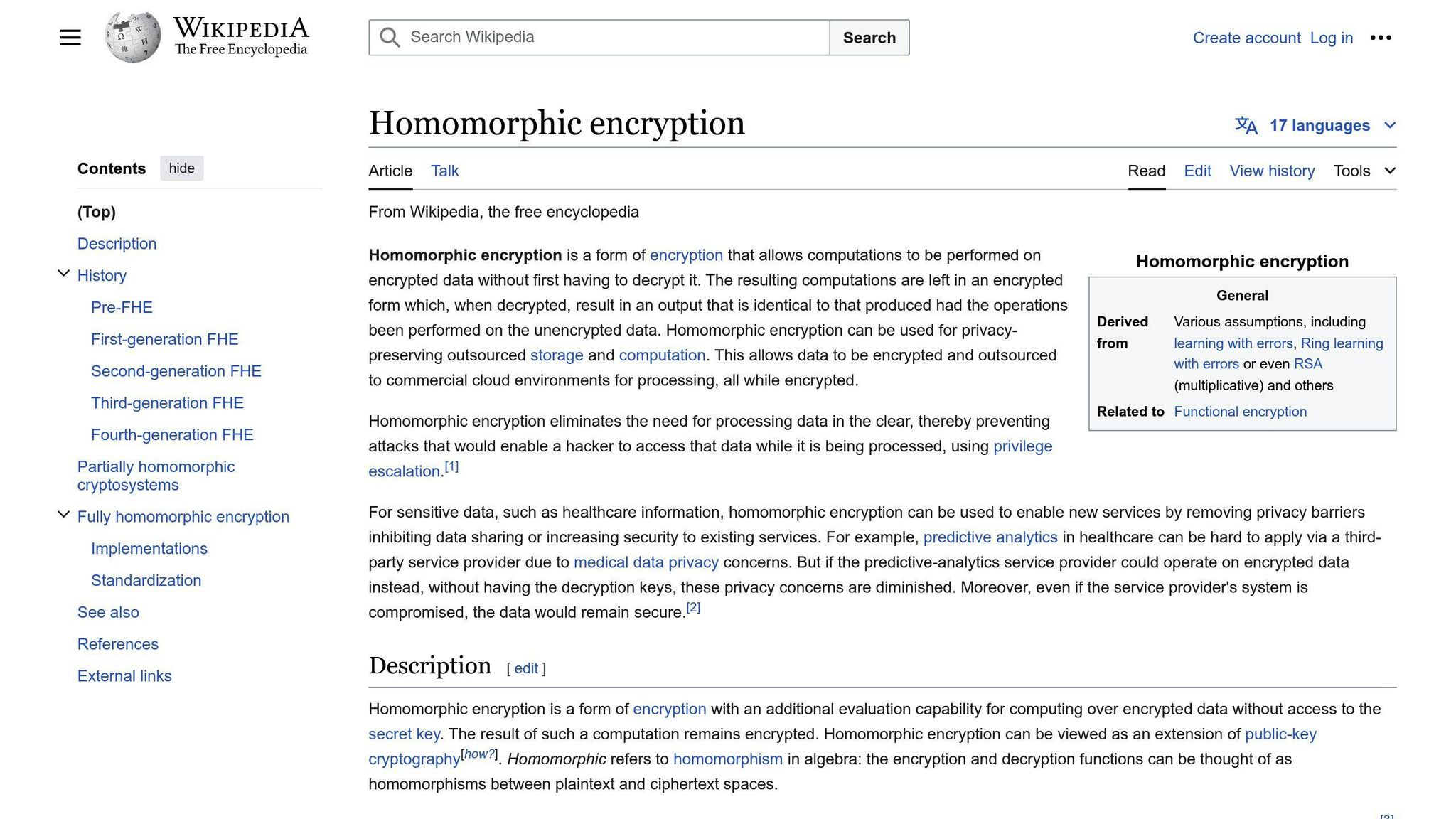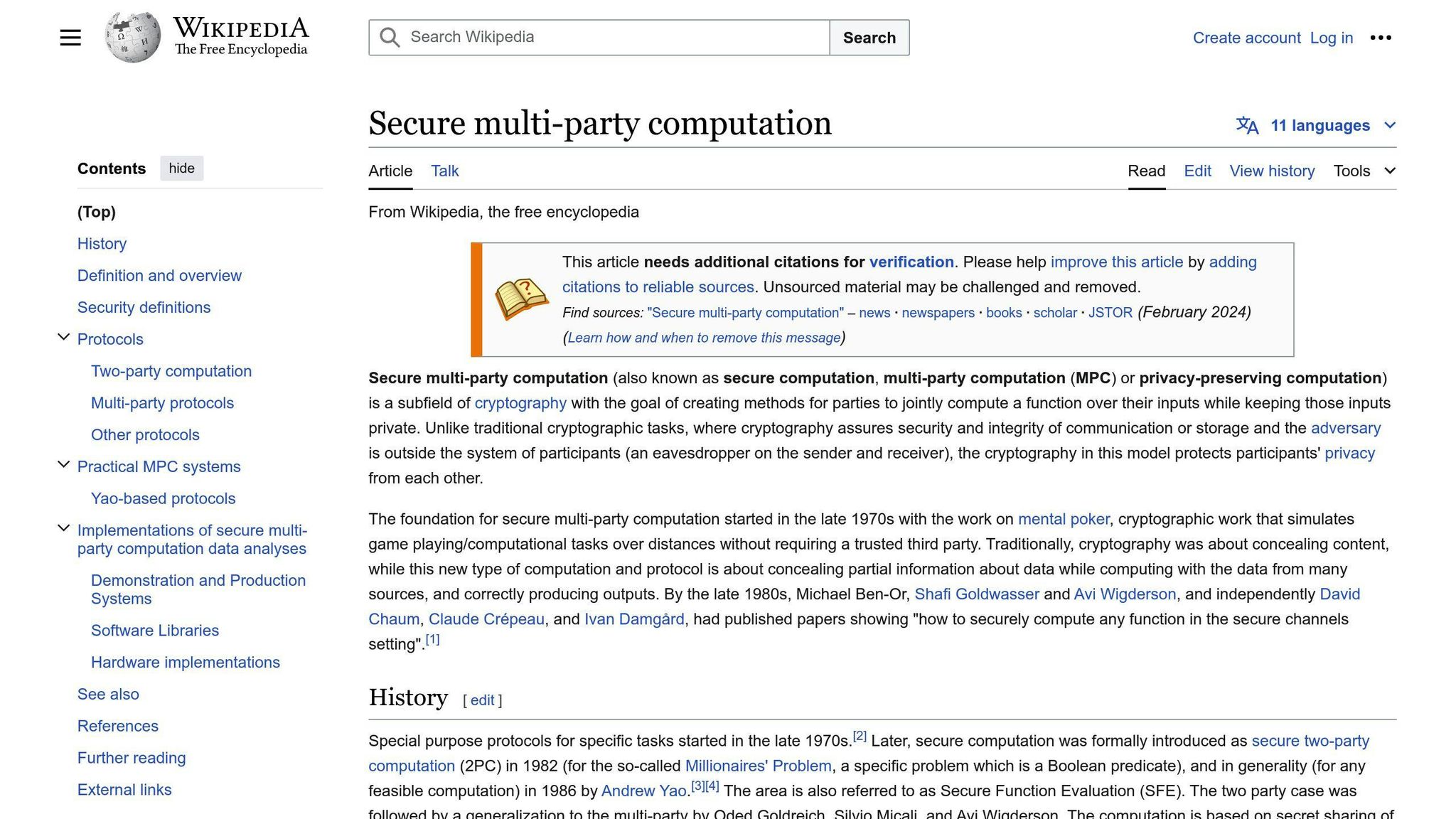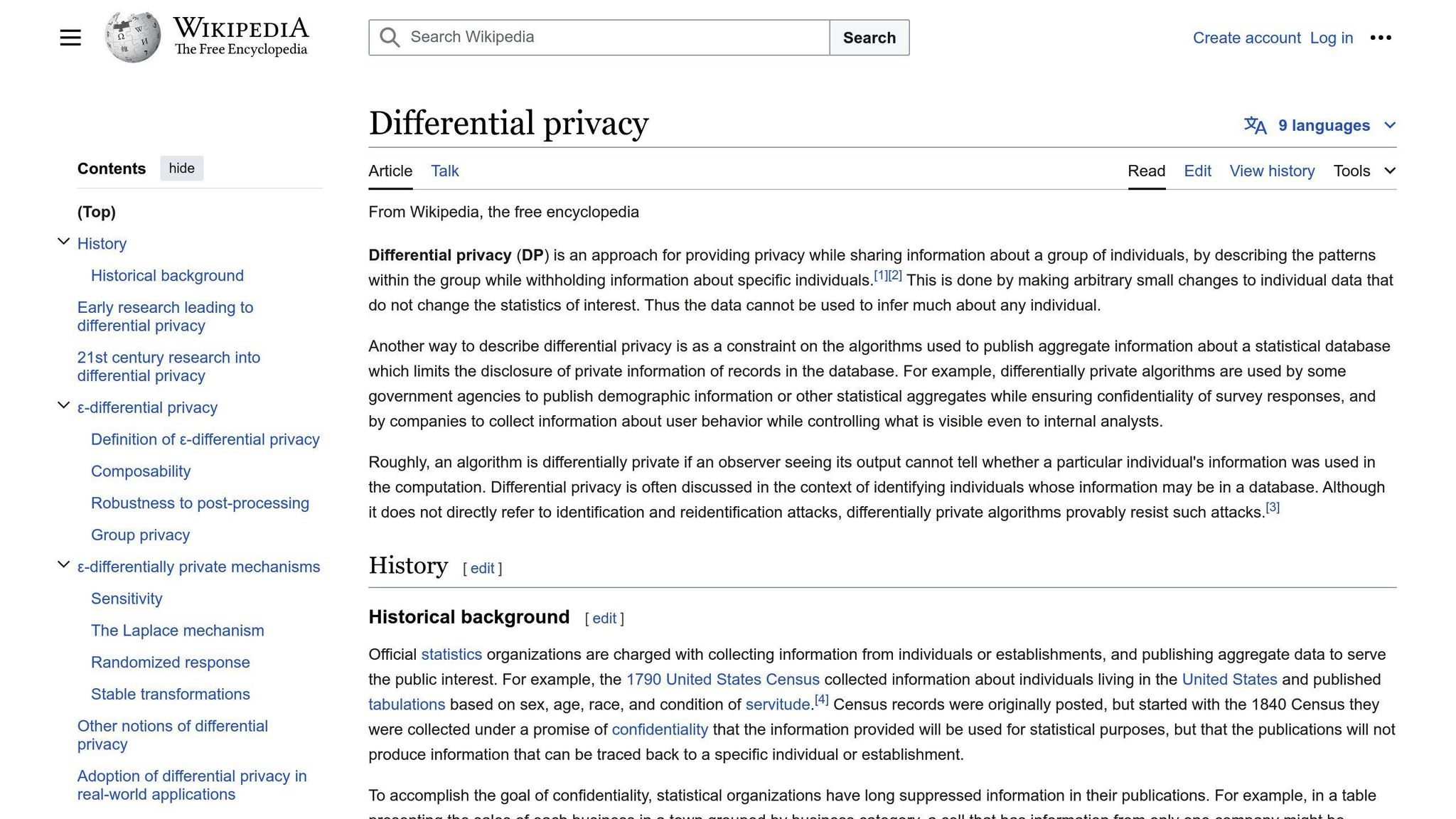
Privacy-Preserving Data Sharing: Guide for Edge Networks
Four proven techniques to secure data sharing in distributed networks while staying compliant and maintaining smooth operations.

Written by
Adam Stewart
Key Points
- Pick the right privacy method based on your security needs and available resources
- Spot data vulnerabilities that are specific to edge computing environments
- Balance data accuracy with protection using clear evaluation methods
- Enable secure collaboration while meeting all regulatory requirements
Privacy-preserving data sharing allows organizations to securely share sensitive data while protecting individual privacy. This guide explores techniques to address privacy challenges in edge networks:
Key Privacy-Preserving Methods
- Homomorphic Encryption: Enables computations on encrypted data without decryption, ensuring high security but computationally intensive.
- Secure Multi-Party Computation: Allows multiple parties to jointly compute a function without revealing individual inputs, offering strong privacy guarantees but complexity.
- Differential Privacy: Adds noise to data to prevent individual identification, preserving utility but with potential accuracy trade-offs.
- Federated Learning: Trains machine learning models across devices without centralizing data, maintaining data locality but with communication overhead.
| Technique | Working Principle | Benefits | Drawbacks |
|---|---|---|---|
| Homomorphic Encryption | Encrypts data to allow computations on ciphertext | High security, flexible processing | Computationally intensive |
| Secure Multi-Party Computation | Multiple parties jointly compute without revealing inputs | Strong privacy, flexible processing | Complex, resource-intensive |
| Differential Privacy | Adds noise to prevent individual identification | Preserves utility, prevents identification | Potential accuracy trade-offs |
| Federated Learning | Trains models across devices without data centralization | Maintains locality, reduces overhead | Communication overhead |
Real-World Examples
- Autonomous Vehicles: Federated learning allows cars to jointly train models without sharing individual data, improving accuracy while protecting privacy.
- Healthcare: Homomorphic encryption enables secure sharing of patient records between hospitals, enhancing care while maintaining confidentiality.
- Industrial IoT: Secure multi-party computation allows devices to securely share data, improving efficiency while protecting sensitive information.
Implementation Steps
- Identify sensitive data requiring privacy protection.
- Select a suitable technique based on data sensitivity and network architecture.
- Implement the chosen technique, ensuring compatibility with existing infrastructure.
- Test and validate the effectiveness of the privacy-preserving measures.
Adopting privacy-preserving data sharing techniques is crucial for protecting sensitive information, maintaining customer trust, and enabling secure innovation in edge networks.
Related video from YouTube
Understanding privacy-preserving data sharing
What is it?
Privacy-preserving data sharing is the practice of sharing sensitive information while protecting individual privacy. It allows organizations to share data while keeping personal details confidential.
Why is it important?
In today's data-driven world, data sharing is crucial for innovation, collaboration, and informed decision-making. However, sharing sensitive information can compromise privacy and trust. Privacy-preserving data sharing techniques help organizations:
- Comply with regulations
- Maintain customer trust
- Enable innovation through data sharing
Key principles
The main goal is to balance data utility and privacy. This is achieved by implementing techniques that protect sensitive information while preserving the usefulness of the data. Key principles include:
| Principle | Description |
|---|---|
| Data minimization | Collecting and sharing only the necessary data for a specific purpose. |
| Anonymization | Removing or altering identifying information to prevent re-identification. |
| Encryption | Protecting data with encryption techniques for secure transmission and storage. |
| Access control | Limiting access to data to authorized individuals and organizations. |
Differences from traditional data sharing
Traditional data sharing often prioritizes data utility over privacy, leading to sensitive information being compromised. In contrast, privacy-preserving techniques prioritize privacy while still enabling useful analysis and collaboration. This approach is particularly important in industries where data sharing is necessary, such as healthcare and finance.
Privacy threats in edge networks
Edge networks process data closer to the source, which can lead to privacy risks. Understanding these risks is key to protecting sensitive information.
Potential privacy threats
Edge devices are often spread across different locations and connected to networks, making them vulnerable to:
- Physical access: Devices could be tampered with or stolen.
- Network attacks: Hackers could access devices through network connections.
- Data exposure: Sensitive data processed at the edge could be exposed.
- Device vulnerabilities: Limited resources and infrequent updates make edge devices attractive targets.
Risks of data sharing
Sharing data in edge networks can result in:
| Risk | Description |
|---|---|
| Data leakage | Sensitive information could be leaked or accessed without authorization if encryption and access controls are not properly implemented. |
| Unauthorized access | Data could be accessed by unauthorized parties, leading to breaches and privacy violations. |
| Lack of transparency | It may be difficult to track data provenance and ensure accountability. |
Addressing privacy threats
To protect privacy in edge networks, organizations should:
- Encrypt data: Use encryption for data in transit and at rest to prevent unauthorized access.
- Implement access controls: Strictly control who can access and process data.
- Anonymize data: Remove identifying information to protect individual privacy.
- Update regularly: Keep edge devices and software updated to address security vulnerabilities.
Privacy-Preserving Techniques for Edge Networks
In edge networks, protecting sensitive data is crucial. This section explores various techniques suitable for preserving privacy in edge networks, including their working principles, benefits, drawbacks, and a comparison table.
Homomorphic Encryption

Homomorphic encryption allows computations on encrypted data without decrypting it first. This ensures sensitive information remains protected throughout processing. It's particularly useful in edge networks, where data is processed closer to the source, and security risks are higher.
Benefits:
- High security
- Flexibility in data processing
Drawbacks:
- Computationally intensive, impacting performance
Secure Multi-Party Computation

Secure multi-party computation enables multiple parties to jointly compute a function without revealing their individual inputs. This approach ensures strong privacy guarantees, as each party's data remains private throughout the computation process. It's useful in edge networks where data from multiple sources needs to be processed together.
Benefits:
- Strong privacy guarantees
- Flexibility in data processing
Drawbacks:
- Complex to implement
- Requires significant computational resources
Differential Privacy

Differential privacy adds noise to data to prevent individual identification. This ensures data remains private and secure, even when shared with third parties. It's useful in edge networks where data is processed and shared across multiple devices.
Benefits:
- Preserves data utility
- Prevents individual identification
Drawbacks:
- Potential accuracy trade-offs
Federated Learning

Federated learning enables multiple devices to jointly train a machine learning model without sharing their local data. This ensures data remains private and secure while allowing collaborative model training. It's useful in edge networks where data is distributed across multiple devices.
Benefits:
- Maintains data locality
- Reduces communication overhead
| Technique | Working Principles | Benefits | Drawbacks |
|---|---|---|---|
| Homomorphic Encryption | Encrypts data to allow computations on ciphertext | High security, flexible processing | Computationally intensive |
| Secure Multi-Party Computation | Multiple parties jointly compute without revealing inputs | Strong privacy, flexible processing | Complex, resource-intensive |
| Differential Privacy | Adds noise to prevent individual identification | Preserves utility, prevents identification | Potential accuracy trade-offs |
| Federated Learning | Trains models across devices without data centralization | Maintains locality, reduces overhead | Communication overhead |
Each technique offers unique advantages and limitations, making them suitable for different use cases in edge networks. By understanding their strengths and weaknesses, organizations can choose the most appropriate approach to protect sensitive data and ensure privacy in their edge network deployments.
sbb-itb-ef0082b
Implementing Privacy-Preserving Data Sharing
Implementing privacy-preserving data sharing in edge networks requires careful planning and consideration of various factors. This section provides practical steps and recommendations for successful implementation.
Challenges and Considerations
When implementing privacy-preserving data sharing in edge networks, you may face these challenges:
- Sensitive Data: Edge networks often handle sensitive data like personal health or financial information, requiring robust privacy protection.
- Network Architecture: Edge networks have unique requirements, such as distributed processing and real-time data processing, which can impact the choice of privacy-preserving technique.
- Computational Resources: Edge devices often have limited computational resources, which can affect the performance of privacy-preserving techniques.
Step-by-Step Guide
Follow these steps to implement privacy-preserving data sharing in edge networks:
- Identify Sensitive Data: Determine which data requires privacy protection and categorize it based on sensitivity.
- Select a Technique: Choose a suitable technique, such as homomorphic encryption, secure multi-party computation, differential privacy, or federated learning, based on data sensitivity and network architecture.
- Implement the Technique: Develop and integrate the selected technique into the edge network, ensuring compatibility with existing infrastructure and devices.
- Test and Validate: Perform thorough testing and validation to ensure the technique effectively protects sensitive data and maintains data utility.
Best Practices and Recommendations
To ensure successful implementation and maintenance of privacy-preserving data sharing mechanisms in edge networks, follow these best practices:
- Conduct Regular Security Audits: Periodically assess the edge network's security posture to identify and address vulnerabilities promptly.
- Monitor Data Access: Implement access controls and monitoring to detect and respond to unauthorized data access attempts.
- Provide Training and Education: Educate edge network administrators and users on privacy-preserving techniques and best practices for effective implementation and maintenance.
- Stay Up-to-Date: Continuously monitor emerging threats and update privacy-preserving techniques to address new risks and vulnerabilities.
| Technique | Working Principle | Benefits | Drawbacks |
|---|---|---|---|
| Homomorphic Encryption | Encrypts data to allow computations on ciphertext | High security, flexible processing | Computationally intensive |
| Secure Multi-Party Computation | Multiple parties jointly compute without revealing inputs | Strong privacy, flexible processing | Complex, resource-intensive |
| Differential Privacy | Adds noise to prevent individual identification | Preserves utility, prevents identification | Potential accuracy trade-offs |
| Federated Learning | Trains models across devices without data centralization | Maintains locality, reduces overhead | Communication overhead |
Each technique offers unique advantages and limitations, making them suitable for different use cases in edge networks. By understanding their strengths and weaknesses, organizations can choose the most appropriate approach to protect sensitive data and ensure privacy in their edge network deployments.
Real-world examples
Autonomous vehicles
Self-driving cars generate lots of sensitive data like location, speed, and sensor readings. This data is processed in real-time to help the cars drive safely. To protect privacy, car makers can use federated learning. This lets multiple cars jointly train machine learning models without sharing their individual data. So the models get better without exposing private info.
For example, researchers at UC Berkeley made a system where cars shared model updates without revealing their data. This improved model accuracy and reduced data transmission.
Healthcare data sharing
Healthcare providers often need to share patient data while keeping it private. Edge networks can help by using homomorphic encryption. This lets them do computations on encrypted data. So hospitals can share patient records without exposing sensitive details.
At UC San Francisco, researchers made a system using homomorphic encryption to securely share patient data between hospitals. This led to better patient care and lower costs.
Industrial IoT
Industrial IoT systems collect sensitive data from many devices. Edge networks can ensure privacy by using secure multi-party computation. This lets multiple parties jointly compute on private data without seeing each other's inputs.
Researchers at the University of Illinois made a system using this technique for industrial IoT. Devices could securely share data, improving efficiency and reducing costs.
Key lessons
These examples show why privacy-preserving data sharing is crucial for edge networks:
- Privacy techniques are needed: Edge networks require strong privacy methods to securely share sensitive data.
- Collaboration is key: Effective data sharing requires multiple parties working together, enabled by privacy techniques.
- Technique selection matters: The right privacy technique depends on the specific use case and data needs.
- Implementation is critical: Careful planning, addressing challenges, and thorough testing are vital for successful implementation.
Future trends and developments
New technologies for data privacy
Several new technologies could change how we protect data privacy in edge networks:
- Blockchain: Blockchain provides a secure, decentralized way to share data. It enables safe transactions without a central authority.
- Homomorphic encryption: This encryption allows computations on encrypted data without decrypting it first. It enables secure data analysis while keeping information private.
- Differential privacy: These techniques add noise to data to prevent identifying individuals. This collects sensitive data while maintaining privacy.
These technologies have the potential to greatly improve data privacy in edge networks. They provide secure frameworks for sharing data and enable private data analysis.
Impact on privacy
New technologies like blockchain, homomorphic encryption, and differential privacy can help reduce privacy risks in edge networks. By enabling secure, decentralized data sharing and private data analysis, they keep sensitive information protected.
Areas for more research
While promising, these technologies need more research and development for edge networks:
- Scalability and performance: Solutions must scale to large edge networks while maintaining efficiency.
- Integration: Different technologies and systems must work together seamlessly for secure data sharing.
- Standards and regulations: Clear standards and rules are needed to govern using new technologies while ensuring data privacy.
| Technology | Description | Benefits |
|---|---|---|
| Blockchain | Decentralized framework for secure data sharing | Enables safe transactions without a central authority |
| Homomorphic Encryption | Allows computations on encrypted data | Enables secure data analysis while keeping data private |
| Differential Privacy | Adds noise to data to prevent individual identification | Collects sensitive data while maintaining privacy |
Conclusion
Key Points in Brief
This guide explored the importance of protecting sensitive data in edge networks through privacy-preserving data sharing techniques. We discussed the risks of traditional data sharing and introduced methods like:
- Homomorphic Encryption: Allows computations on encrypted data without decryption.
- Secure Multi-Party Computation: Enables joint data processing without revealing individual inputs.
- Differential Privacy: Adds noise to data to prevent individual identification.
- Federated Learning: Trains models across devices without centralizing data.
We provided steps for implementing these techniques and real-world examples of their use.
Why Adopt Privacy-Preserving Methods
As edge networks grow, organizations must adopt privacy-preserving data sharing to:
- Protect sensitive information
- Maintain customer trust
- Comply with data privacy regulations
Moving Forward
We encourage organizations to take action and implement privacy-preserving techniques in their edge networks. Doing so will enable secure, efficient data sharing while safeguarding customer privacy and data security. This guide offers insights and practical advice to help you on this journey.
| Technique | How It Works | Advantages | Limitations |
|---|---|---|---|
| Homomorphic Encryption | Encrypts data to allow computations on ciphertext | High security, flexible processing | Computationally intensive |
| Secure Multi-Party Computation | Multiple parties jointly compute without revealing inputs | Strong privacy, flexible processing | Complex, resource-intensive |
| Differential Privacy | Adds noise to prevent individual identification | Preserves data utility, prevents identification | Potential accuracy trade-offs |
| Federated Learning | Trains models across devices without centralizing data | Maintains data locality, reduces communication overhead | Communication overhead |
Summarize with AI
Related Posts
Federated Edge AI: The Complete 2025 Guide to Privacy-Preserving Distributed Intelligence
Explore the benefits of Federated Learning and Edge AI in preserving privacy while leveraging AI power. Learn about real-world applications and privacy protection strategies.
Differential Privacy for Edge AI Security
Learn how differential privacy enhances security in edge AI systems by protecting sensitive data and ensuring privacy. Explore the benefits, challenges, and future research directions.
Homomorphic Encryption Guide: Secure Edge AI
Learn how homomorphic encryption secures sensitive data in edge AI systems. Explore benefits, challenges, and future outlook. Discover the importance of privacy preservation in edge AI.
Federated Learning for Privacy-Preserving Edge Computing
Explore federated learning for privacy-preserving edge computing, decentralized training, privacy protection, collaborative learning, and regulatory compliance. Learn how to set up the environment, prepare data, initialize the model, train local models, aggregate model updates, update the global model, and evaluate and monitor the system.
